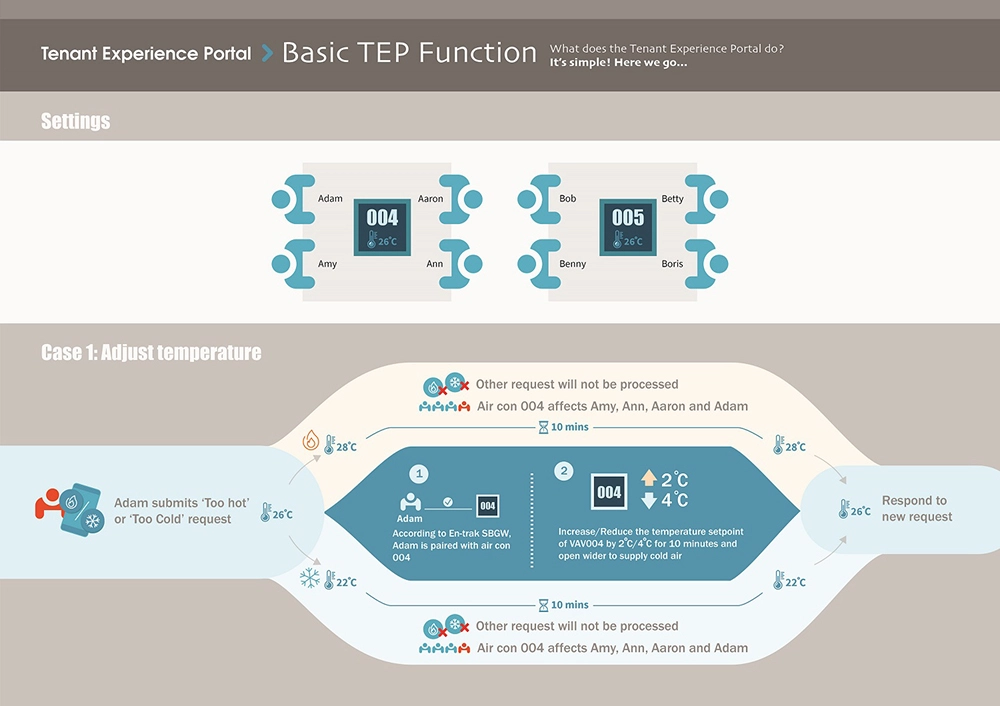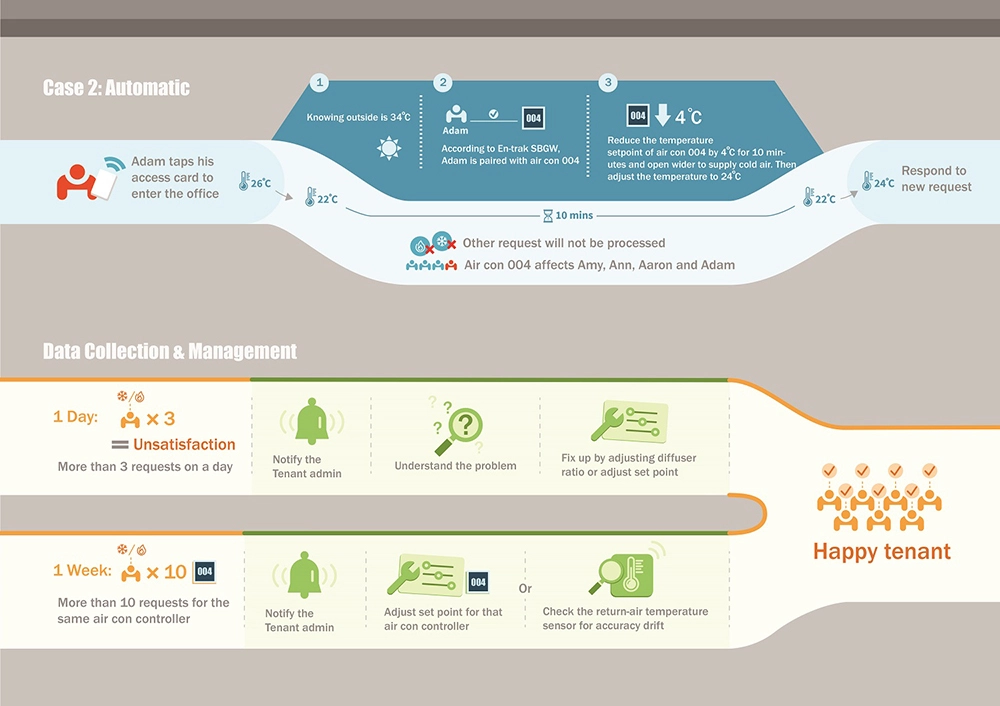HVAC On-demand
Why most offices are overcooled
Have you ever sat in the office, freezing from the air con, without saying anything because you don’t even know who you should ask to fix it?
Maybe you wear a jacket in the summer just to keep comfortable.

Central air conditioning systems in commercial office buildings are engineering marvels, but they aren’t perfect. Multi-tenant offices are complex environments and thus it’s difficult to get the temperature “just right” for everyone. More often than not, the landlord ends up overcooling the office for lack of a better option.
This can have a noticeable and negative impact on the landlord. Overcooling keeps energy costs high even as businesses strive to reduce their carbon footprint. More importantly, tenant discomfort negatively affects the landlord’s brand. Higher operating costs and lower revenue – not ideal!
So how did we get here? Why is the status quo a situation where nobody benefits?
Most Grade A commercial buildings use VAV (variable air volume) systems to deliver chilled air to tenanted areas. This has many benefits, but it also largely shifts control from the occupant to a central BMS (building management system). So, when a tenant moves in, the air conditioning settings run on a centrally-set default, usually the same temperature setting for each vent in the office. But each area has different needs, whether they’re different preferences or different occupancy levels, and these needs change over time.
So, if building management selects a “recommended” temperature setting like 25°C, it’s very likely that some areas will end up hotter than that – creating uncomfortable tenants and lots of complaints. And those complaints won’t simply go away over time, because the occupants will keep sweating and sweating – there’s not much they can do about it on their own. If building management decreases the temperature to 23°C, they’ll cool the previously hot areas, but areas that were previously comfortable will now be chilly. While this may generate complaints of its own, they are likely to be fewer and stop after a while. Why? Because “cold” is a problem an occupant can solve on their own, whether by wearing a jacket or physically blocking a vent (both are common!).
So, with fewer complaints, nobody worries too much about the extra energy use, or the quietly freezing occupants in their summertime jackets. The situation is by no means ideal, but it is stable.
This is where we are today, in the modern offices of 2019, as the planet heats up.
Well, that’s not entirely fair. Many landlords have tried to improve the situation, usually in one of two ways.
Option A: Raise the temperature settings and make a big announcement about doing this together with the tenants in the name of sustainability. There are limits to this approach – before long even the most eco-friendly occupants will need to say, “enough is enough” (in some cases on day one of the temperature increase!).
Option B: Respond to tenant complaints by adjusting temperature settings for individual zones. Of course, this depends on complaints reaching the building management team in the first place, and with enough information for them to decide which zone to adjust and by how much. Moreover, adjustments of this type are not made instantly – only after many, many complaints are the temperature finally adjusted, by which time the situation in the office may have changed. This is all logistically challenging.
Luckily, technology now allows landlords to take both of these approaches without sacrificing either tenant comfort OR their own productivity. The result is a dynamic office climate that responds to occupant needs and preferences throughout the day, reduces energy use, and doesn’t require direct action from the building management team.


How does it work?
It starts by connecting the air con units (VAV boxes or FCUs) in the tenanted area to En-trak Tenant Experience Portal (TEP), a cloud-based platform. Occupants are given a controlled form of access to these units through the TEP mobile app, where they can make requests for cooler or warmer temperatures in their assigned zones.
With this new tool in place, the building management team can now safely increase the default temperature. This may make some areas uncomfortably warm, but this is no longer a problem – occupants can directly request cooler air using the mobile app.
The app will direct an immediate but temporary response – a burst of cool air for 10 minutes. Experience shows that this temporary cool-down will solve a majority of warm temperature complaints and does not require the temperature settings to be permanently changed.
If requests for cooler air in that zone continue, however, then the default setting can be adjusted automatically, or the building management team can be notified for manual changes.
Now instead of freezing the whole office to keep a few areas from getting too warm, or keeping everyone sweating in the name of sustainability, the landlord can provide a comfortable temperature for each individual zone. Instead of standing as a middleman between the occupants and their air conditioning, the landlord can step back and let the occupants interact with the air conditioning directly (through a smart system that prevents abuse!)
With new but straightforward technology like TEP, the days of office overcooling are over. New levels of energy savings (and emissions reductions) can be achieved. And nobody has to suffer for it!
About En-trak
En-trak is an award-winning proptech company backed by Alibaba and CLP. We help CRE landlords create a comfortable, productive and sustainable work environment.
Our core solution is the En-trak Tenant Experience Platform – a customer-facing application for CRE landlords to enable building occupants to control & personalize their workplace temperature & lighting using their smartphone.
Founded in 2013, En-trak solutions are used and trusted by over 350 world-class customers in Asia including Hong Kong Stock Exchange, Hong Kong Convention Centre, Sino Group, City Developments Limited and many others.